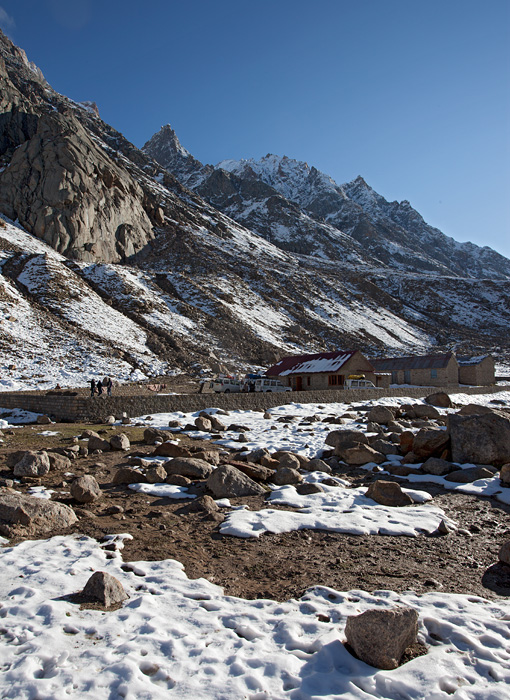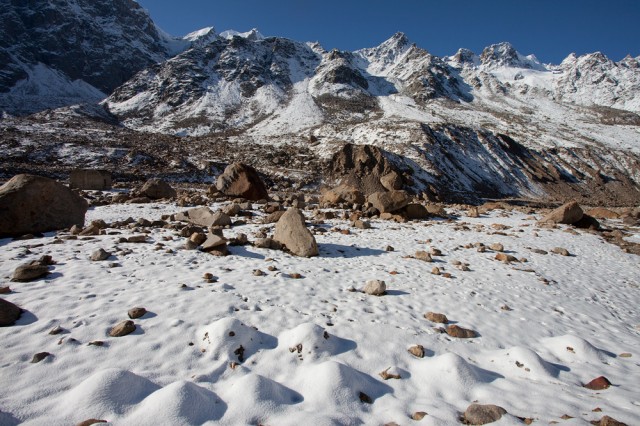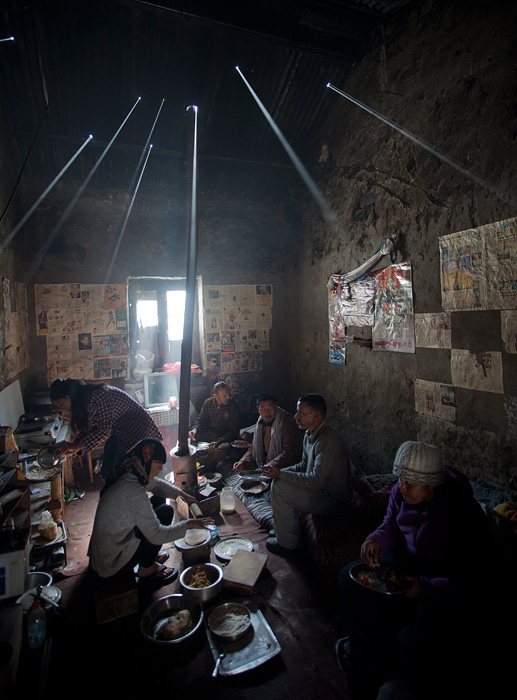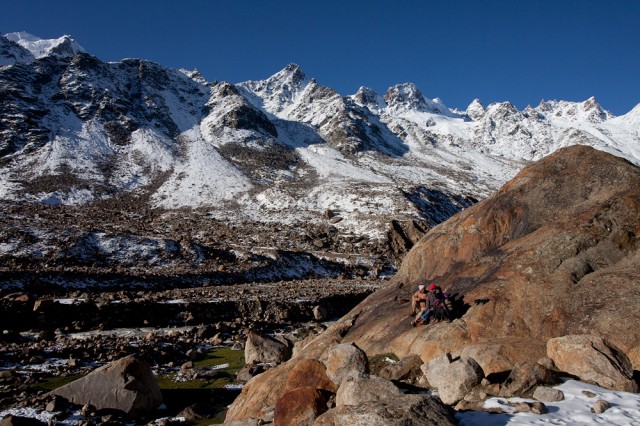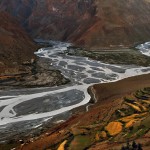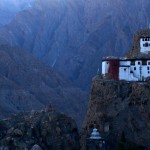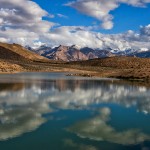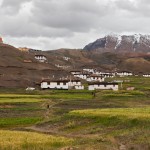Stranded in a Storm in Lahaul & Spiti – A Week of Uncertainties
Bridges had fallen and the roads were cut off. A long line of waited for many hours hoping for things to get better. Buses were cancelled and they had no clear answers to when the services will resume. “It depends on the weather, sir,” was the fence-sitting answer from the person manning the phone at the bus company, who neither had any real-time information nor had powers to provide decisive answers.
Himachal Pradesh was seeing heavy rains in the past few days. As it happens every year, landslides had crippled the road infrastructure and there was a cloud of uncertainty over what happens next. Unpredictable as the weather here is, things might magically settle back to normal next morning. Or it could very well turn worse if another line of dark clouds made their way towards the mountains.
My local contact constantly kept me updated on all the information he was able to procure. He had someone or the other in every part of Himachal giving him updates. Yet, nothing seemed certain. I turned to Twitter, looking for all the latest information that one could ask for. I had become like a journalist with a undying fetish for breaking news, scouring for every information that I could get, so that I can make informed decision on our next move.
Chandratal. This is where we were headed before the weather gods made us change plans.
The road from Delhi to Manali was affected by incessant rains that had brought down a bridge at someplace 100km before Manali. Himachal Parivahan had cancelled the night’s bus, since the bus that had left the previous evening from Delhi had not reached Manali yet. Nor did the buses from Manali make it to Delhi. We were stranded in Delhi for a night and were struggling to know the current status, so that we know what to do on the next day. My logistics organizer insisted that we rent a car and just head out, as someone would be working at the bridge and everything would be fine by the time we make the ten hour journey to the point-of-problem.
He was right in hindsight, but I held back from the decision with a concern for the safety of our group. Was it still raining in those parts? Can we be sure that there won’t be more landslides that would affect our journey, even if the fallen bridge is repaired? How sure can we be about reaching Manali safely?
I had all the answers available only next morning. The skies had cleared up. Work on the bridge would be complete soon and it appeared safe to go. We set off from Delhi in anticipation of magical landscapes of Spiti. We were to know later that this was not the end of our troubles, but only a beginning of many surprises and obstacles that we would face in the next eight days.
The journey to Manali was uneventful and went according to schedule. The bridge was repaired and the road offered no other surprises. We reached Manali at an unearthly hour of 2.30am, making a 14 hours journey by car and arriving 14 hours later than the initially planned time of arrival. Lara, our guide for the journey ahead was asking us to leave Manali in the next hour, but we were too tired after the long journey. Yet, we took off after a short nap, leaving Manali at 6.30am. If all went well, we were going to be on the road for another ten hours.
But all the calculations had gone wrong again. The rains in the last few days had transformed the slopes of Pir Panjal ranges into a mountainous mass of slush. We were stranded behind a long line of vehicles trying to avoid skidding along the slimy road and get across Rohtang Pass to Lahaul, Spiti or Ladakh.
In the last two years, Rani Nala had become infamous with taxi driver of Manali region. The road next to the stream here kept sinking lower and lower no matter how much the Border Roads Organization tried to repair it. There was a long stretch of a several hundred meters where vehicles had to wade foot-deep slush, desperately hoping that the wheels don’t get stuck. More often than not, drivers faced clutch-burns on the slippery path, getting stuck and awaiting their turn to get rescued by BRO’s cranes. The process was slow, often had unpredictable results and sometimes took hours before a loaded truck could be made to continue on the road. Others had to wait patiently before their adventure across Rani Nala commenced, repeating the whole process all over again.
Four years ago, I did not have any of these problems on the road from Manali to Rohtang Pass. Even in the pouring rains that lasted for the whole day, we cruised smoothly without any hold-ups on the road. Rohtang then was not a dreaded ‘R’ word like it had become now. So what went wrong? I checked with a few cab drivers and locals from Manali. Cab drivers, as they usually do, complained about organizations responsible for the upkeep of the road and said nothing else. But Amar, a farmer in Manali who also owned a cab gave me better insights.
Traffic jams were a norm on the road to Rohtang during every summer’s tourist rush, although the road scaled well when the visitors retreated after the rains began. According to Amar, the BRO set on the task of widening the roads three years ago. They blasted and dug up the slopes in the process, when the real troubles started. The loose soil of the slopes in Pir Panjal Ranges was not able to sustain the road widening process. The slopes gave away, rocks came falling down and the ground started sinking slowly. The damage could not be reversed easily, and the widened road could not be completed. But the road had to be kept open to heavy traffic that took supplies to Lahaul Valley and Ladakh Region. The trucks had to ply to ensure steady flow of materials, no matter how bad the road is, making things worse by the day. This was especially troublesome near Rani Nala, which was becoming a horror-story for all the drivers who took these roads.
On that day of the slow and uncertain journey, we crawled on the road to Rohtang Pass, cheering every time we moved a few inches and hoping that we will be out from this place soon. Sun was shining today and our prospects looked good. Yet, it took as long as noon for our first glimpse of the slush-ridden road near Rani Nala. Hopes soared as we expected to move through the point-of-problem soon, but it took another four hours before we managed to get past. At 4.30pm, when we were finally out of trouble, we looked forward to a smooth journey through glorious landscapes ahead, thinking about sunshine over a pristine lake that we would be expecting next day. But once again, we had hoped for too much, too soon!
During a typical monsoon season, rains begin in Himachal Pradesh in the first week of July and go on till September. During these three months, mountain slopes often see sudden downpours that throw life into disarray, followed by days of calm. We were in the middle of one such week when the dark clouds had emptied, and there was a breather before the next one would arrive.
But all this play of weather was normally confined to the region south of Rohtang Pass, which includes the long winding road to Manali and another 60km journey uphill to reach the pass. The moment you cross Rohtang and descend into Lahaul Valley on the other side, wet weather disappear and reveal a barren high-altitude landscape. Pir Panjal Ranges — the mountains that grow over 13,000 feet and host Rohtang Pass — block all the monsoon clouds, creating two entirely different landscapes on its either sides. South of Rohtang and around Manali, the mountains are covered with green grass in the high ranges and a dense pack of deodar trees in the lower region. To the north, slopes are brown and naked. There is not a tree to sight even after driving for miles. Rains are a rarity, and beyond some level, not even desirable. A torrent of rains, like the storms in Manali can be dangerous. The loose soil on the slopes in Lahaul Valley can bring down rocks from the mountain slopes and cover the valley with rubble.
I was eager to get past Rohtang Pass, not just to escape the ordeals of Rani Nala, but also to find some sun, dry weather and the glorious landscapes that awaited us in Lahaul, and later at Spiti Valley. I was returning to Spiti after six years and was eager to be in those mountains. I anxiously awaited the next day when we would be at Chandratal Lake, easily the most beautiful place I have seen in all my travels in the Himalayas.
But fate had made other plans for us. Across Rohtang too, weather had taken an unusual turn. In the summer months, when the temperatures should be in twenties during the day and the weather is usually clear, we saw the ground covered in a two feet snow. Pregnant clouds were continue to lighten their burden even in the arid landscapes of Lahaul Valley. It was, however, a sight to remember, seeing the road cutting through the white snow that had transformed the look of Lahaul Valley. Our group rejoiced to see the spectacle and loved the show that nature had hosted for us. But knowing the nature of roads in Lahaul and the potential damages that precipitation can cause, I was beginning to get worried.
My fears were not unfounded. As we turned from Manali-Leh National Highway, sections of the road had been slowly getting washed away by the streams that rushed down from the hills carrying tonnes of mountain soil. Stones awash from the slopes were littered on the road. But for our able driver Vinod and the vastly experienced guide Lara, we would have turned back and headed home. But our crew knew this game and lead us with confidence.
We drove through unending rain for next couple of hours, past the summer settlement of Chatru followed by a long unpopulated stretch (imagine such a thing in India!). It was dark now and we had altered our plans to reach our camping location near Chandratal, and instead planned to reach the first available settlement at Batal and stay there for the night.
It turned out, road to Batal wasn’t easy either.
It was beginning to get dark soon after we left Chatru. It was raining continuously and visibility was low. On occasions, our vehicles was wading through a road that had almost become a stream. Clearly, things weren’t looking good. I looked forward to reaching Batal and settling down for the night – not because it wasn’t a comfortable journey, but in concern for the group’s safety. Somewhere along the way, we found a few vehicles struggling to get across an area where the road had become very slushy. A couple of Tata Sumos had to go back and forth until they could find surer grounds and get get across the slush. Next, it was the turn of a Qualis before we could try to get past the slush. Half-way through the crossing, it got trapped in foot-deep mud and had to struggle considerably. We watched worriedly for more than 15 minutes, but the Qualis did not move an inch. Inside the vehicle were a couple led by a driver, without a guide. After a long struggle, the couple were asked to shift to one of the Tata Sumos and go ahead, while the driver would try to get the vehicle out. Meanwhile, our driver Vinod had found a safer way out and we could continue the journey.
All along, it continued to pour and situation of the road only seemed to be getting worse. Another 20 minutes later, we reached a circuit house of Himachal Pradesh Public Works Department, where the Tata Sumos that had gone ahead were waiting. With the continuing rain in these fragile mountain ranges, no one was sure how safe it would be to make the hour-long journey from here to the next settlement at Batal. We had about 40 people spread over several vehicles. After much discussion among the local people on whether it is prudent to go to Batal (still 20km away) where there was food and accommodation for everyone, or to play safe and spend the night at the circuit house, concern for safety won over staying in comfort. It was decided that all the forty of us will spend the night here and think about the next action in the morning.
The circuit house at Chota Dhara that came to our rescue that night.
In the times of adversity barriers tend to vanish and people unite like they never do. That night, solidarity was at display when forty people had to find a means of squeezing into a place that had two bed rooms.
The caretaker of the circuit house was a fantastic man who was willing to do anything in his ability to help us. He threw open the rooms, gave away every blanket he could spare and let the stranded travellers settle as comfortably as it could possibly be. Half a dozen people curled into a bed that can normally take two. People even slept on the floor, shivering in the cold and barely managing to get any shut eye. Even the kitchen was used for sleeping, which was perhaps a good place to be in, considering the warmth. Some of us decided to fall asleep in the vehicle, which wasn’t a bad idea as we could turn on heating when it got very cold.
Throughout the night, it rained uninterrupted. Occasionally we heard thundering sounds somewhere faraway, perhaps rocks tumbling down from the mountains. Some worried men and women came out from the circuit house in the middle of the night to check if everything was alright. But we were safe. We were spending the night at a wider section of the valley, where the slopes were reasonably faraway on one side for boulders to roll down and consume us. The river at the bottom of the valley too, was at a fairly good distance on the other side to swell and flood the circuit house.
As the temperatures dipped with the falling rain, it turned into snow fall. Thermometer in our car displayed numbers slightly below zero. Despite all the troubles, we were thrilled to witness an unlikely summer time snow in August. As the night turned to dawn, we saw a foot-high white blanket covering the earth, transforming the complete atmosphere.
We saw a blanket of snow covering the Lahaul Valley.
The next morning, weather gods appeared a bit pleased and the rains had subsided, save for occasional drizzles. Our mood was unusually upbeat for what we had gone through. Although we were stranded, we were safe. While we weren’t exactly comfortable, we weren’t in a miserable situation either. We had shelter from elements of nature, and most importantly, it turned out that there was enough food available until we could find a way out of here.
A considerable number of people stranded — about two-thirds of us — were local people who knew how to handle these situations. A lot of them were travelling from Manali with some groceries, which they were glad to share. The caretaker willingly opened up his store-room to ensure that we get enough to eat. A large number of volunteers turned up at the kitchen to prepare food and ensure that the stove kept burning until everyone was fed. The people were so friendly, so willing to work, so helpful and maintained such high spirits, I felt grateful to be in their company than be worried about being stranded. Everyone remained cheerful, but never oblivious to the situation.
In fact, at some point in time it even turned into merry making. A couple of teenage girls sat down and took turns to make Aloo Parathas for everyone, singing happily all the way. It also became time to sit and talk, catch up on old stories between friends and idle around doing nothing. The overall mood in the circuit house was anything but dark. We hardly sounded like a bunch of people stuck in adverse weather in remote mountains.
I went out after a breakfast of maggi to see what the roads looked like. The damages caused by the rains was hard to believe. In many places, there was nothing left to indicate that a road existed a day before. Flowing water had created foot-deep canals at many places. Big stones had rolled into the road. At a place where a stream ran down from the mountains, there was such a deep gash in the road that it wasn’t even possible to walk across.
With the roads so bad, it was unlikely that our vehicles could go far in either directions. The Spitians in our group had already charted the next steps. It was time for local government to get involved in getting us out. But someone had to tell them that there are people stranded. So, a bunch of people decided to walk to the summer settlement of Batal — about 20km ahead on the road — where a satellite phone was available.
Whatever be the outcome of this exercise, condition of the roads was such that there was no way we would get out of Chota Dhara today. We had to be ready for at least another night at the circuit house, may be longer.
The day passed comfortably, with some merry making, preparing lunch and whiling away the time. Thankfully, precipitation had stopped for good and it allowed us to go out and explore the surroundings. It gave us an opportunity to divert our attention from the weather and appreciate the beauty of the snow-sprinkled landscape around us. The fresh, butter-like snow had gently spread itself uniformly all along the ground. Mountains rose high and steep in all directions, appearing threatening and overpowering yesterday, but grand and powerful today. The stopover had given us an opportunity to sit back, reflect and appreciate the mountains than go around from one place to other during the course of our visit.
The kitchen of the circuit house at Chota Dhara had become a hub of activity and a warm, comfortable place to hangout.
About 4pm that evening, all the fury had vanished from the sky. The clouds parted suddenly to reveal the perfect blue skies typical of normal summer day in Lahaul & Spiti. Sun shined in the west, letting us bask in his warmth as we relished on the the beauty of the snowy landscape. The mood had become casual and relaxed; any undercurrents of anxiety had completely melted. Now, it was a matter of waiting for the earth-movers and rescue teams to arrive from Kaza. But we still did not know if it would take a day, two or a whole week. Uncertainty prevailed.
It is worth reflecting a bit on the mood in our group when all these things were happening. When we made the delayed start from Delhi, all that we had in mind was to reach Manali as soon as possible and continue the journey further to Spiti. At Rohtang Pass, while we waited for the queue of vehicles to get past Rani Nala, no one felt a need to get impatient. This was a completely new experience for everyone. While we waited, the grand theater of nature played out its spectacle, with a display of green and white mountain slopes interspersed by small streams rushing down the deep cliffs. The fresh mountain air and the scenic landscapes allowed a diversion from the wait and made the process painless. It also helped that there wasn’t any rain, which would have confined us inside the vehicle.
It was a moment of jubilation soon after we crossed Rani Nala. A sense of having made it through all the uncertainties, now in anticipation of good times. Once we crossed Rohtang, everyone was excited to see the blanket of snow, except a worried me wondering about the road ahead. Further ahead, a mark of concern appeared on all our faces as we watched the water gushing into the road at places. As we decided to spend the night at Chota Dhara, most of us perhaps felt discomforted, but not troubled. We did not face any damages on the road, so it was now a matter of awaiting the next dawn.
Next morning, when we realized the situation and discovered that we may not get out of this place soon, no one seemed to have the slightest concern about being stranded. We had food and shelter, so it was a matter of waiting in some discomfort that we did not mind anymore. And through the day, we were having a good time either in the company of Spitians or gaping at the mountains. At any point in time as these events unfolded, no one appeared excessively worried, troubled or felt desperate. The people of Spiti had a large role to play in this. Not to forget: without our expert guide who could take us through any kind of situations and a driver who always had full control of his vehicle, we would probably be scared to death not knowing what to do.
Clouds disappeared in the evening, letting us bask under the sun and wait for the roads to be repaired.
On the second morning at Chota Dhara, we still had no idea about the state of the road ahead. The place had no connectivity whatsoever. So, even if the repair work was in good pace, we would not know until they reached us. Speculations were rife about our options and there were talks about walking to the Batal.
The good news arrived at about eleven in the morning. Earth-movers had reached a place about 5km from where we were, but the damages further ahead on the road was terrible and it would take another day or two before they reached Chota Dhara. Soon, we packed our bags, dumped them all in the vehicle and started walking towards the repaired road with a day-pack on our shoulders. In the next two hours, we were back on the road awaiting transportation to the next town.
To our surprise, a large gathering of officials from the local government had arrived there to ensure that we were safe and healthy. The good folks who had made the journey by foot yesterday had described the situation as grave, and the district administration had assumed the situation to be what we later heard as ‘mass casualty’. Waiting for us at the roadhead was a group of policemen, people in district administration, a doctor and a bunch of genial Spitians who were roped in for the ‘rescue operation’.
With everyone in perfect shape and not a speck of injury on our bodies, we were amused to see these preparations but were also impressed by the turnout. An ambulance too was called in, which took some more time as it had to wait for the snow to be cleared.
Everything that happened next was mostly formalities. A girl in our group was still left in Chota Dhara at our guide’s care, as she felt unable to walk. The policemen went to assist and to get her back on the road. Once she arrived, we moved ahead cruising happily towards comfortable beds and hot showers waiting for us at the other end.
A day later, we were in Spiti Valley enjoying a warm weather and beautiful sights.
I was leading this visit to Lahaul & Spiti on a photography tour for Darter Photography in August 2011. Reflecting on the incidences that took us by surprise at every turn, if there is one thing that I can distinctly remember is the goodness of Spitians who were stranded with us. They did everything in their ability to ensure we were safe and comfortable. The good men who made the 20km walk to make that phone call suffered considerably, but never complained about it. They were snow-blinded and had to be treated for heavily swollen eyes later, with a bandage covering the eyes and unable to see for two full days. Yet, they never talked big or made even the slightest remark about their sacrifice. Our guide Lara, a Spitian himself, kept us in good spirits, was available for us all the time and ensured that we were safe till the end. The district government acted promptly, taking no chances and making sure that each one in the group was safe and healthy. The caretaker of the circuit house was a hero, who was responsible for sheltering us from the elements and keeping our stomach full. Our group too, remained brave and curtailed any anxiety, staying together as a team and never sparking any emotional trauma of being stranded. Looking back, I remain grateful to all of these people who remained at their best despite the adversities.
Despite all these experiences, I returned to Spiti next summer, again guided by the able hands of Lara. Not knowing how to express my gratitude, all I could do was to carry some mangos and apples for the caretaker at Chota Dhara. This time, we faced none of the challenges we encountered last year. It was a smooth journey across Rohtang Pass, where the roads had been finally fixed for good. Across the pass in Lahaul & Spiti, the weather was at its perfect best and the journey was as smooth as it could get. Not a stone fell from the slopes and not a moment was spent hoping for better weathers. The mountains, however, continued to effuse the same charm as ever. Spiti will continue to be a place that I go back to, despite all that we went through during that fateful journey.

